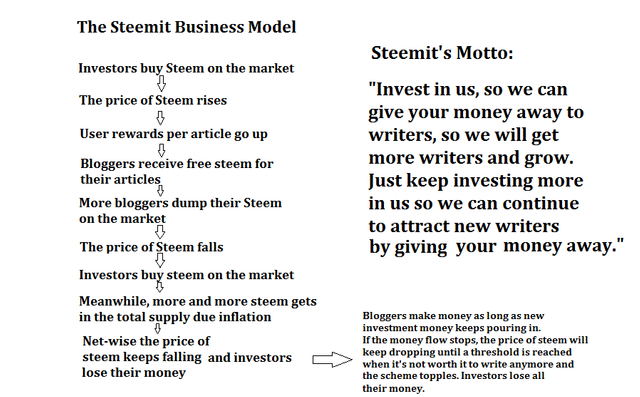Is this an accurate representation of Steemit's business model?
I am trying to figure out how the Steemit business model exactly operates and this is what I've drawn together so far. Not trying to troll, please correct me if I am wrong.

I am trying to figure out how the Steemit business model exactly operates and this is what I've drawn together so far. Not trying to troll, please correct me if I am wrong.

The value of "network effect" is missing from your equations.
https://en.wikipedia.org/wiki/Network_effect
Add in tons of users = something that can be turned into a revenue stream for SP holders -> demand for SP goes way up -> early investors retire rich ;)
Revenue stream how? This has never been explained. There is very little that can be charged to users by SP holders that can't be charged to users by non-SP holders (meaning open competition will drive these revenues way down). The exception being maybe charging for access to the network itself, but that is such a huge long shot given current realities of charging for access to anything online, it wouldn't make sense for anyone to risk much money on the extreme outside chance that you can get users to pay a lot for a social media platform or a payment system "someday" in the future. Or am I somehow wrong about that?
There are many different ways to add revenue streams, but most of them would require a significant user base. Anything along these lines would be "someday" in the future things.
The most basic form would be some type of advertising model (similar to what Facebook has) where businesses could place advertisements on the site. @ned has mentioned in a few interviews the possibility of forming a non-profit corporation to facilitate/run an advertising platform on top of Steemit.
Nothing is decided / set in stone though. This is all just prediction / speculation what Steemit could become.
Advertising would be a function of the UI, and in centralized systems revenue is facilitated by having tight control over the data and user metrics (for targeting). Again, competition would drive revenues down; users wouldn't even need to resort to the ad-blockers and do-not-track features that have become popular, they could just chose a UI that doesn't include ads or trackers in the first place. Furthermore there isn't particularly anything to ensure that UI operators actually pay any of that revenue back to stakeholders (in fact those that do would likely be at a competitive disadvantage on the advertiser revenue side because their CPM or whatever rates would likely be higher).
I think this is an extremely challenging problem, with solutions that may come in the future, especially as the platform evolves significantly, so I'm not overly pessimistic (and 100% agree that it all requires a much larger user base to be significant and doesn't matter now). But I don't see easy answers now like "just add advertising" as being good answers.
That is correct and I agree with everything you say. I did not mean to imply that it is an easy problem to solve.
With sites like busy.org and steemit.com being the main ones (at least as of now) it would be up to them to decide on whether they want to include advertisements, and whether the revenue would be returned back to SP holders (in part or in full). @ned's proposal (which would be for Steemit.com) was that the revenue would be returned to SP holders.
As far as competition - sites would need to provide added value that could not be easily replicated in clones. That in of itself is a difficult challenge, especially when dealing with open source. It is not impossible though.
We need lots of engaged users first though, and in order to attract/retain more users there are still a lot of missing ingredients. My hope/belief is that we will get there. Not sure how quickly though..
Spotted a translation error. What I mean with "Net-wise" is "overall"
You forgot the part were people pay to get extra attention to their content. It's called advertising and it's what drive almost all of the internet content economy at this time.